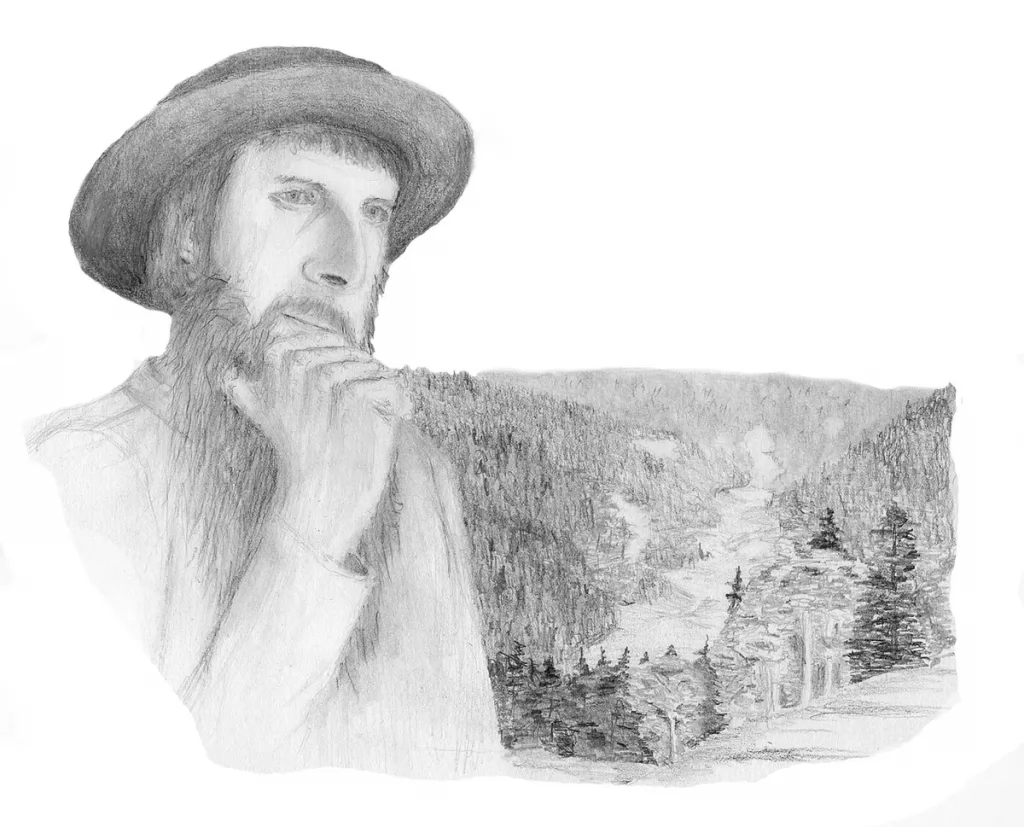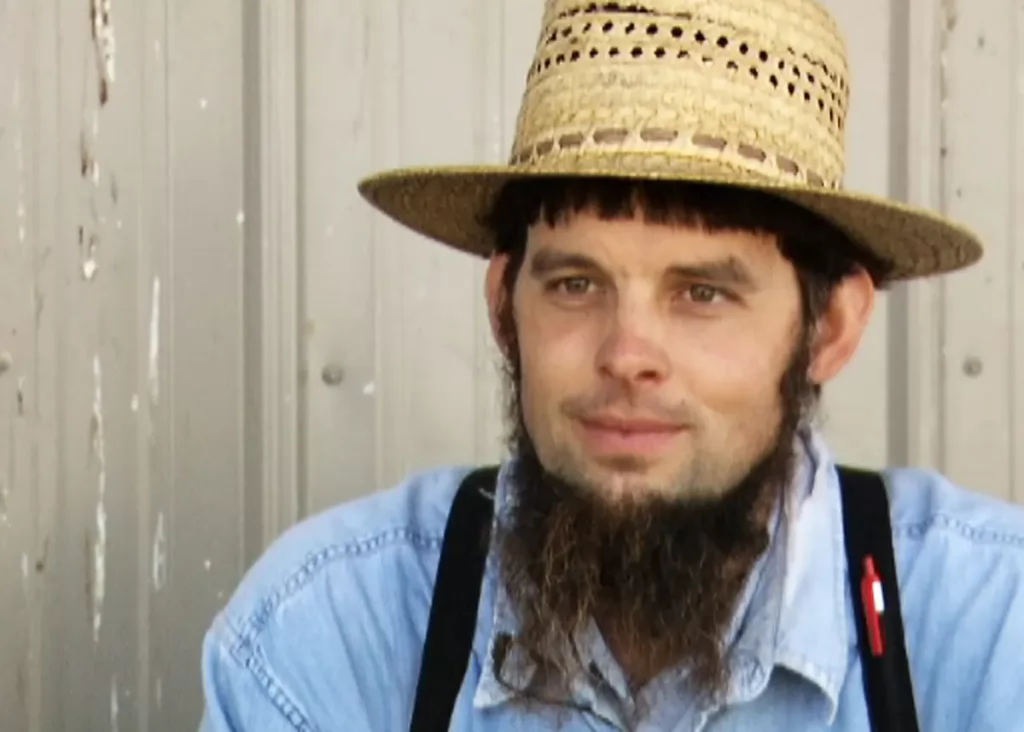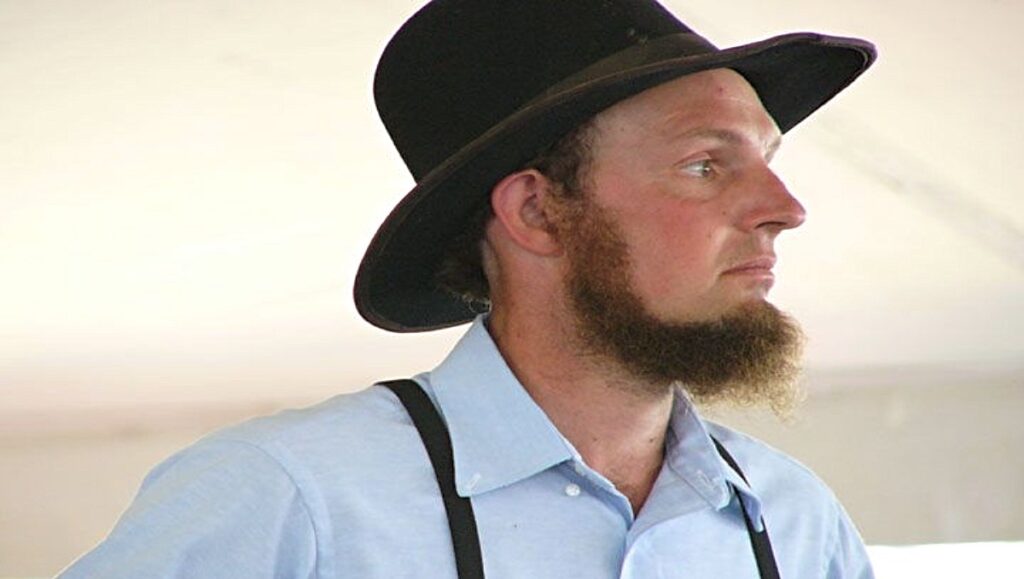
In the heart of America’s countryside, amidst rolling hills and expansive farms, the Amish community lives a life steeped in tradition and religious devotion. Among their many practices that intrigue outsiders, one particularly distinctive custom is that Amish men do not shave their beards after marriage.
Key Takeaways:
- -Inspired by Jakob Ammann, the Amish beard tradition symbolizes humility and divine intention.
- -Shaving is avoided as it goes against the natural process intended by God.
- -Amish beards signify adulthood, marriage, and faith, marking a critical life transition and embodying community values.
- -Amish men avoid mustaches due to military associations.
- -Beards hold deep meanings worldwide, from wisdom in Orthodox Christianity to identity in Sikhism and Islam. The Amish beard is part of this global reverence for facial hair.
Let’s peel back the layers and explore the rich tradition behind Amish beards, uncovering what each strand represents in their world.
The Origins of the Amish Beard Tradition
The beard tradition takes us back to when every thread of fabric and hair was imbued with meaning. This isn’t just about sporting a Shenandoah; it’s a narrative deeply stitched into the fabric of Amish beliefs, reflecting a commitment to a life lived through the principles of simplicity and faith.
Jakob Ammann’s Influence
Jakob Ammann, a name that resonates with the echoes of Mennonite history, marked a pivotal chapter in the spiritual narrative that led to the birth of the Amish community.
Around the late 17th century, he challenged the Mennonite tradition in Switzerland, Alsace, and southern Germany. He had radical teachings, like the social shunning of excommunicated members and the ex-communication of those who lied.
Drawing inspiration from Jesus, Ammann incorporated washing into worship, advocated for uniform dressing, and voiced a compelling argument against trimming beards and attending state church services.
What’s genuinely captivating is how Ammann’s influence shaped the unique identity of the Amish beard. He believed that if a man could grow a beard naturally, it was what the higher power intended. To him, shaving went against the natural process and divine intention.
The ripple effect of Amann’s teachings continued within Europe. As Amish communities spread to Russia, Holland, and, notably, North America, the essence of his guidance on simplicity, humility, and community solidarity traveled with them.
A Global Reverence for Beards
The Amish have made a name for themselves with their distinctive beard traditions; however, they’re not the only religious group that values facial hair for more profound reasons.
Orthodox Christians often view beards as marks of wisdom and devotion, while Sikhs profoundly respect the body’s natural state. Additionally, various Jewish communities, Muslims following the Sunnah of Prophet Muhammad, and even the Rastafarians each offer unique perspectives on the significance of a beard.
Michael Silber, a professor at Hebrew University with expertise in beards, mentioned that specific Orthodox Jewish communities, guided by Jewish mystical writings, regard facial hair as so sacred that men avoid combing their beards to prevent hair loss. He also noted that hairs that shed naturally are occasionally kept in prayer books for preservation.
The following table offers an overview of beard traditions across different cultures, highlighting how each reflects its values, challenges, and benefits.
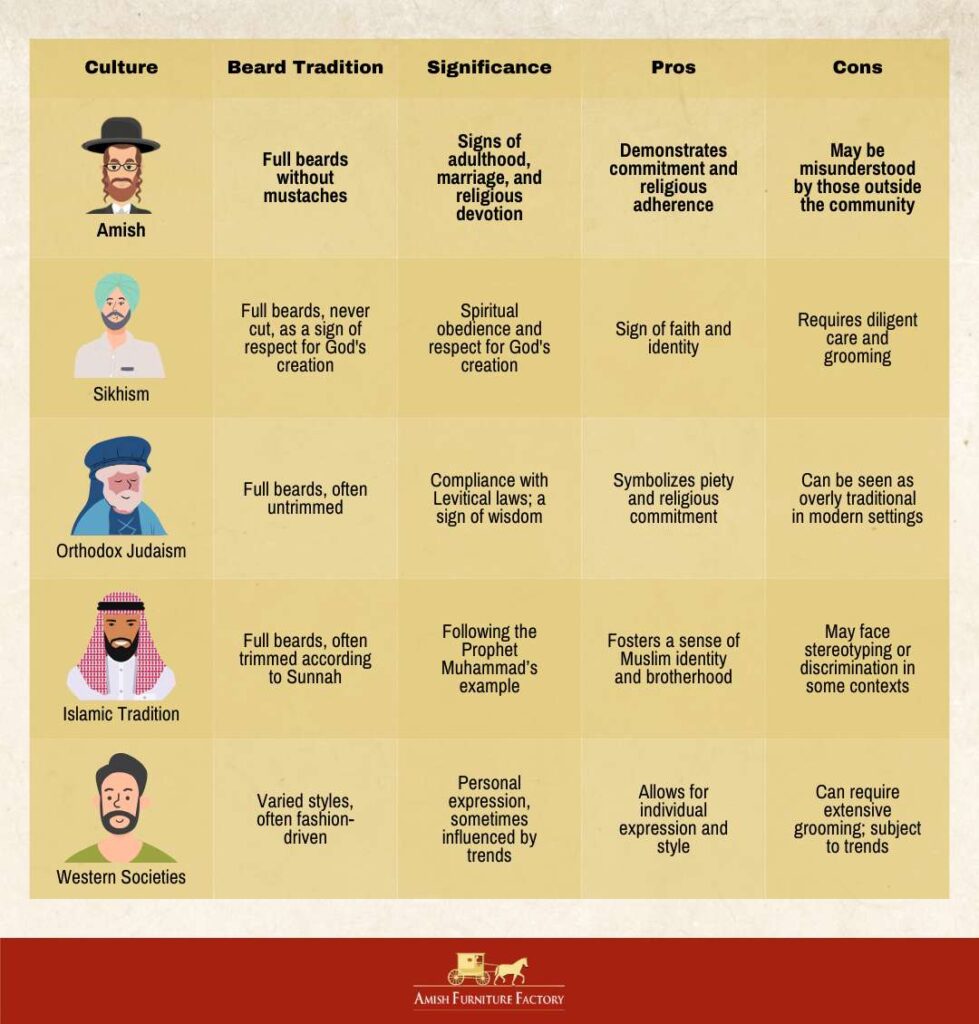
The Significance of the Beard in Amish Culture
Each thread has its place, tradition, and purpose for the Amish. And the beard? It’s more than just facial hair; it’s a canvas of beliefs, a declaration of faith and identity.
Religious Beliefs on Amish Men’s Facial Hair
Amish men’s approach to facial hair is deeply influenced by their religious beliefs, grounded in specific biblical passages that underscore a commitment to humility and community values.
Leviticus 19:27: This verse advises against altering the natural edges of one’s beard, reflecting a broader principle of living in a way that respects the creations as they are made. The Amish interprets it as an instruction to maintain beards naturally without shaving or trimming the edges.
Psalm 133:1-2: This passage celebrates unity and brotherhood, using the metaphor of anointing oil flowing down Aaron’s beard to illustrate the blessing of communal harmony. For the Amish, the uncut beard symbolizes living according to one’s community and faith.
Marital Status of an Amish Man
When an Amish man ties the knot, it’s more than just swapping rings; it kicks off the beard-growing journey.
That beard he starts to grow? It’s not just facial hair. It tells the world he’s taken a step into a new chapter of life where he’s not just a man but a partner and provider. His beard is weaving together his personal growth with more profound spiritual and community commitments.
Harrison Wesley Brown from Eastern Illinois State College hit the nail on the head back in ’53 with his take, saying:
“The wearing of a beard is a sign of fertility and marks a change in the behavior of the man from that of a boy to a man.”
This insight from decades ago remains relevant, especially when we look at the steadfast traditions of the Amish. It’s a powerful reminder that some things remain timeless, like the deep-seated meanings behind Amish beards.
The Amish Experience with the Military
In the historical backdrop of tense colonial times, British redcoats posed more than just a challenge to early American settlers. They had a knack for giving a hard time to many, including our peace-loving ancestors across the pond in Europe, like the Mennonites and the Amish.Imagine these groups, steadfast in their faith, facing off with soldiers who couldn’t care less about theological niceties.
Now, think about it—no self-respecting Amish man would ever dream of sporting a look that even remotely reminded them of those who brought such grief and turmoil to their communities, not to mention others who shared their beliefs.
This was especially true until World War II, when the Amish commitment to non-violence, or being what the world might label as “pacifists,” truly stood out. Their stance on non-resistance wasn’t just a passive choice; it was an active declaration of their beliefs, a clear line in the sand that they were not about to cross, military associations included.
Understanding the Amish Beard Rules
Laying out the Amish beard rules world feels like walking through an old-growth forest. There’s a sense of wonder, tradition, and a few unspoken guidelines that everyone seems to know. Now, let me explain how I’d describe the delicate joints of a well-crafted chair to a curious customer.
Simple and Untrimmed: Amish beards are usually kept natural and untrimmed, reflecting the community’s emphasis on simplicity and natural living. This rule can vary somewhat between different Amish groups, with some allowing for a more trimmed appearance, but the general preference is for a beard to be left as it grows, without shaping or styling.
No Emphasis on Fashion or Vanity: The Amish culture strongly discourages vanity and pride. Thus, the cultivation of a beard is not for aesthetic appeal but rather for adherence to community standards and religious beliefs. The simplicity of the beard is a reflection of the Amish commitment to a humble and plain lifestyle.
Community Variations: While these rules are widely observed, there can be variations in beard customs among different Amish communities or sects. The interpretation and application of these rules differ, reflecting the autonomy of local Amish congregations in determining their specific practices.
What’s truly beautiful about these rules, if you can call them that, is how they’re passed down—father to son, elder to youth—not through strict mandates, but through lived example and gentle guidance.
It’s the same way I learned furniture-making from my father, who learned from his. It’s about tradition, yes, but it’s also about belonging to something greater than oneself.
Why Do the Amish Prefer Beards But Not Mustaches?
Combining the classic charm of the Amish beard with their deliberate non-mustache policy is like knitting a unique element into the fabric of who they are. It’s a fascinating tradition encompassing history, ideals, and communal life.
A Conscious Stand Against Historical Military Ties
When considering an Amish man’s hearty beard without a mustache, one can’t help but consider the historical backdrop. Picture this: the British military made mustaches a must for soldiers until 1916.
This rule wasn’t about fashion but a badge of military identity and strength. Against this backdrop, the Amish decision to embrace beards while shunning mustaches is powerful.
It’s their way of living deliberately, a life chosen from the shadows of military might and the vanity that often accompanied such symbols of power. This choice is a testament to their pursuit of simplicity and peace, consciously stepping away from the echoes of conflict.
Choosing Humility Over Vanity
In a time when people often focus on themselves, the Amish remind us of their belief in humility and the simple life. The absence of a mustache isn’t just a style choice; it’s a subtle yet profound rejection of the self-centeredness that has historically infused decisions about appearance.
Amish men show their dedication to modesty, free from the trappings of status or dominance, by maintaining a clean-shaven upper lip.
The Collective Before the Individual
This tradition goes beyond personal preference, becoming a collective emblem of faith and unity within the Amish community. It’s a practice that binds, reinforcing the communal fabric and reminding each member of their interconnectedness and shared values.
At the heart of this tradition lies the Ordnung, a compass guiding the Amish through life’s journey with unwritten yet deeply honored rules.
This adherence to communal norms fosters harmony and a sense of collective purpose, firmly rooting each individual in the enduring principles safeguarding the Amish way of life across generations.
What Happens if An Amish Man Can’t Grow a Beard?
The community generally understands and accepts if an Amish man cannot grow a beard due to genetic reasons or other factors. The Amish culture values humility, simplicity, and the intention behind actions rather than their outward appearance alone. Thus, the inability to grow a beard wouldn’t be seen as a failure to comply with religious or cultural standards but rather as a natural variation among individuals.
But what exactly happens in the community?
Community Acceptance
He would still be entirely accepted within his community. The Amish community values each individual’s contributions and intentions over physical appearances. There would be an understanding that this individual cannot fulfill this custom due to reasons beyond his control.
No Alternative Requirements
In this situation, there are no specific alternative practices or symbols that an Amish man would be required to adopt instead of growing a beard. The emphasis would remain on living according to Amish values and the teachings of the Bible.
Focus on Living Faithfully
The individual would continue to focus on living according to the Amish faith and the Ordnung, the community’s set of unwritten rules that guide daily life. His commitment to Amish beliefs and practices in all other aspects of his life would be what’s most important.
Jonah’s Story
Let me share a story that brings this home. Take the case of Jonah, one of the artisans who works with me at Amish Furniture Factory. Jonah’s one of those rare folks who, due to genetics, just can’t seem to grow more than a few wisps of facial hair, let alone a full beard.
Now, in many circles, this might raise eyebrows and spark whispers. But not here, not among the Amish.
From day one, Jonah’s place in our community was as solid as the oak we use in our workshop. His craftsmanship and the care he puts into each dovetail joint speak volumes of his dedication and faith—qualities we hold in high esteem.
Jonah’s situation underscores a powerful truth about our community: acceptance and understanding aren’t just words we throw around; they’re pillars of our way of life. It reminds us all that the principles of maturity, commitment to family, and faith shine through in actions, not appearances.
Can an Amish Man Be Punished for Shaving His Beard?
In the Amish way of life, every action and every decision carries a more profound meaning tied to faith, family, and the community’s collective values.
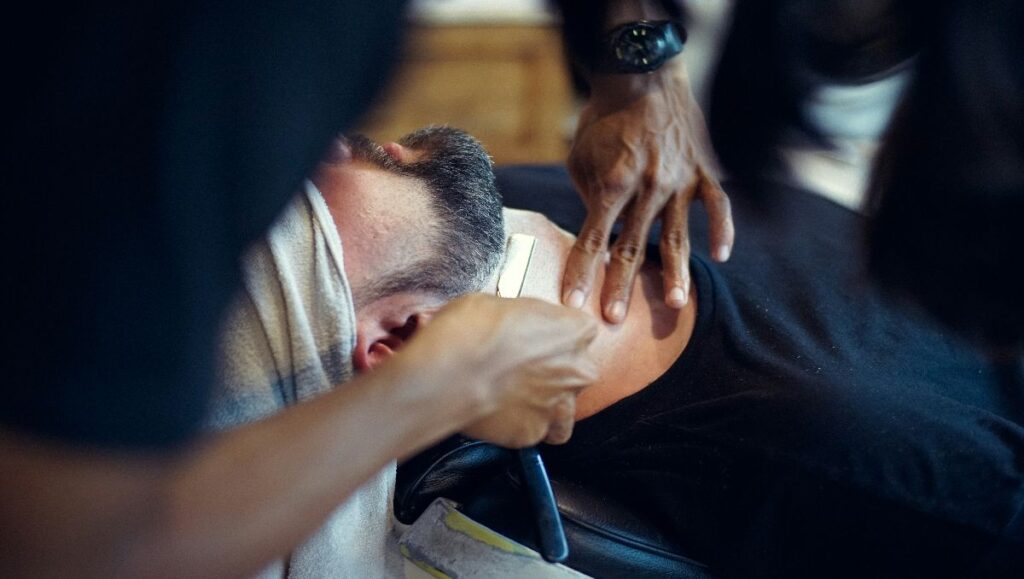
Shaving one’s beard, particularly for a married Amish man, might be seen as stepping away from these shared values. But here’s where it gets interesting—the Amish are known more for their gentle guidance than harsh punishments.
If an Amish man were to shave his beard, it wouldn’t lead to what you’d typically think of as punishment. There are no Amish police knocking on doors about beards.
Instead, this would likely spark a conversation, a kind-hearted check-in from the community elders or the bishop. They’d seek to understand the why, offer support, and gently steer the individual back toward the path that aligns with their collective beliefs and practices.
The Amish community operates on the principles of forgiveness and understanding, valuing the opportunity for growth and learning over retribution.
Should an Amish man shave his beard, it becomes a moment for reflection, both for him and the community—a chance to reaffirm their commitments and perhaps to understand one another better.
Worst Case Scenario
Imagine an Amish man deciding to shave off his beard one morning—an actual departure from what’s expected in our communities. This action doesn’t lead straight to thunder and lightning; reactions can range from a kindly, “Now, why’d you go and do that?” to more severe talks if folks think he’s stepping too far from our shared path.
Should a fellow often march to the beat of his drum, ignoring the Ordnung, he might find himself on the receiving end of Meidung or shunning. It’s a serious step, not to punish, but to give him space to ponder his choices, hoping he’ll find his way back to the fold.
Punishing an Amish man for something like shaving a beard, which might seem small but carries significant meaning, is about keeping the community tapestry intact, ensuring every thread stays true to the pattern they’ve all agreed on.
It’s not so much about punishment as it is about guiding back, about reminding each other of the harmony and values we hold dear.
The Amish Beard in Modern Society
In this era, where your image can be as crafted as a piece of bespoke furniture, the Amish beard stands out like a hand-carved masterpiece in a sea of mass-produced goods.
To some, it might seem a throwback, a nod to times and traditions long past. Yet, this very contrast, this silent proclamation of different values, draws the eye and makes a statement.The Amish beard isn’t just facial hair; it’s a manifesto advocating for a life lived intentionally, rooted in enduring values rather than fleeting trends.
However, navigating these waters has its challenges. While the beard symbolizes simplicity and steadfastness, it can be misunderstood as a mere act of defiance against modernity rather than the expression of deep-seated beliefs it truly is.
It’s a tightrope walk, balancing between living out one’s convictions and bridging understanding in a society that often can’t see past the surface.
Challenges and Considerations
Maintaining the Amish beard tradition faces challenges in today’s fast-paced, technology-driven world. This symbol of humility and simplicity can draw curiosity, admiration, and misunderstanding as global interest in Amish customs increases. Balancing tradition with societal engagement requires careful navigation.
How to Clean and Groom an Amish Beard
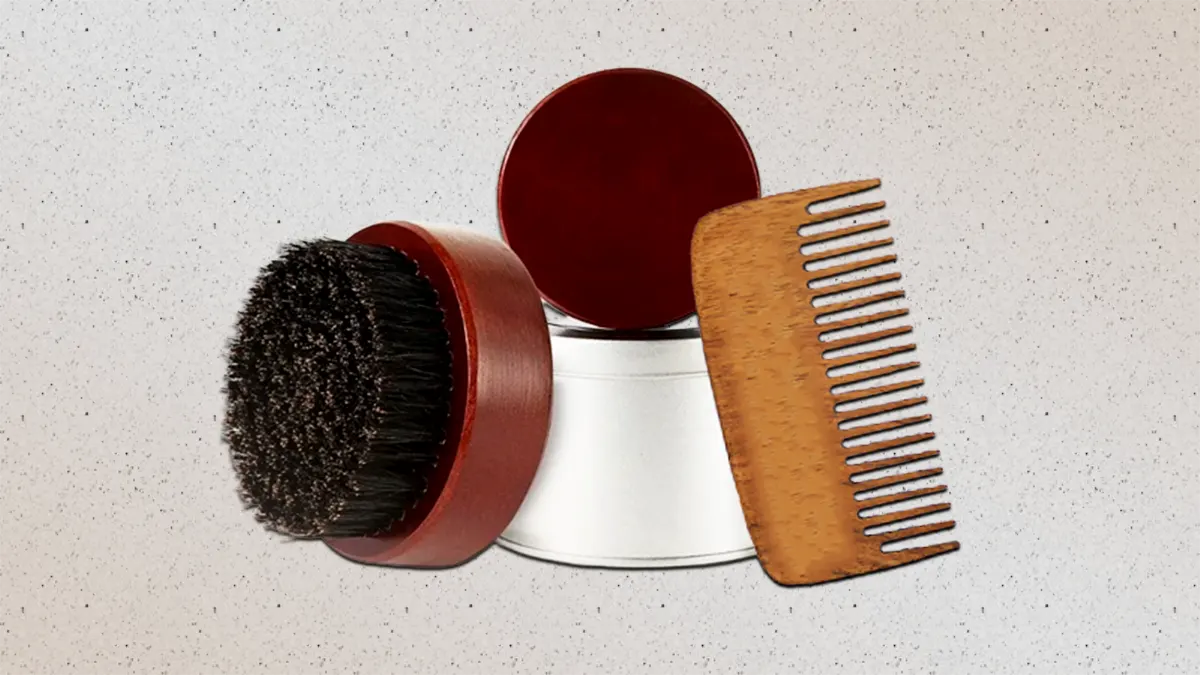
Where simplicity is king, and each action is imbued with the depth of tradition, caring for an Amish beard is akin to the woodworking techniques I’ve mastered through the years—both practices are rich in practicality and reverence for the natural way of things.
Here’s an essential guide on how to maintain an Amish-style beard while adhering to the principles of simplicity and practicality:
1. Washing
Choose a gentle, natural soap or shampoo to wash your beard. Amish people prefer products without strong fragrances or harsh chemicals, aligning with their emphasis on natural living.
Rinse your beard thoroughly with clean water to remove all soap or shampoo residues. This helps prevent skin irritation and keeps the beard healthy.
2. Drying
After washing, gently pat your beard with a clean, soft towel. Avoid rubbing vigorously to prevent damage to the hair and skin.
3. Combing
Use a brush or comb made from natural materials to detangle and style your beard. This is in keeping with the Amish preference for simplicity and natural products. Start from the bottom and gently work up to detangle knots without pulling too hard.
4. Trimming (If Necessary)
While Amish men typically keep their beards untrimmed, some might trim them for neatness or to maintain a manageable length, depending on the specific guidelines of their community. Use scissors for any trimming, rather than electric trimmers, to maintain the connection to traditional, simple tools.
5. Moisturizing
Use natural oils such as jojoba, argan, or coconut to keep the beard soft and healthy. These oils are preferred for their natural properties and lack of synthetic additives.
6. Minimal Products
Consistent with their values of humility and simplicity, Amish beard care avoids using styling products like beard balm or wax, which are common in non-Amish beard care routines.
7. Regular Care
Regular washing, combing, and occasional trimming (per individual and community standards) are vital to maintaining a healthy beard. This routine care prevents tangles and keeps the beard looking neat.
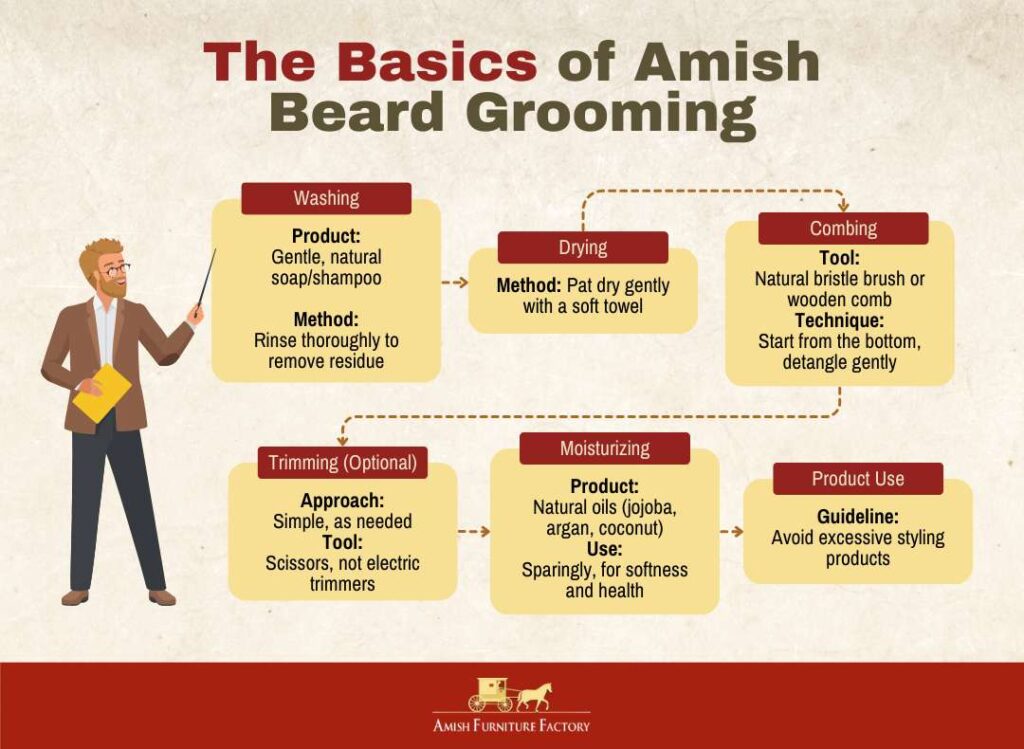
Embracing the Tradition of Amish Beards in a Modern World
In the rolling hills of America’s countryside, the Amish community lives a life rich with tradition and faith, with the Amish beard serving as a meaningful symbol. This tradition, deeply rooted in humility and divine intention, is more than just facial hair; it marks the passage into adulthood, marriage, and a more profound commitment to their beliefs.
Beyond its significance within the Amish community, it connects to a global appreciation of beards that span cultures and religions, from wisdom and identity to spirituality.
But the Amish beard is special. It’s a daily expression of values like simplicity, community, and non-violence, set against modern society’s ever-changing trends. It’s a declaration of a way of life that prioritizes what lasts and matters over what’s fleeting and superficial. In this quiet, steadfast commitment to tradition and faith, the Amish beard isn’t just a style—it’s a statement about identity, belonging, and living intentionally according to one’s deepest convictions.
FAQs
Why do Amish men shave their upper lips?
Amish men shave their upper lips to avoid associations with the military and aristocracy, reflecting their values of humility and simplicity.
What kind of beard do Amish have?
The Amish beard, or “Shenandoah beard,” features clean-shaven cheeks and chin area, with fullness coming from the underside and sideburns connecting to the ears, often kept neat or bushier for a personal touch.
When do Amish men grow a beard?
Amish men start growing a beard after getting married, signifying their transition to adulthood and readiness for family responsibilities.

